
Anallematic horizontal sundial in parking lot
klugesmith, Mon Aug 22 2016, 05:57AMI'm almost ready to paint some anallemas on a parking lot at work, so people can tell time (or even set their watches) by the shadow of a lamp-post about 26 feet (8 meters) tall.
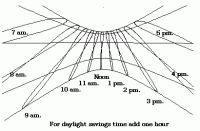
Have been marking the shadow end at various dates and times, and fitting a spreadsheet model to it.
It's popular to annotate anallemas with the associated months and, sometimes, days. I want to have marks about every 10 days, probably days 1, 11, and 21 of each month. Most equation-of-time references use the average over some number of ordinary years and leap years. Here's a chart showing the sun's position along the ecliptic, and shadow's position on a painted anallema, around the February/March transition for several years.

Unless someone has a better idea, I will use the average of 2017, 2018, 2019, and 2020 -- shown with green line. I think an Excel charting bug makes the marker average for Feb.29 not exactly line up with that for Feb.29, 2020.
Re: Anallematic horizontal sundial in parking lot
Sulaiman, Mon Aug 22 2016, 07:15AM
based on similar thoughts;
. cars park on and drive over the paint daily
. try to determine how long the lamp post will be as-is,
it would be annoying if the lamp post was made taller or shorter just after your masterpiece is finished
(e.g. last year, where I work, entire lamp posts were swapped-out for LED lamps )
. how will you get your computer generated precision drawing onto the car park with watch-setting accuracy ?
as a start, each day you could put one or more marks on the car park at key times (e.g. noon, go home ...) which should over the year form nicee lines.
Sulaiman, Mon Aug 22 2016, 07:15AM
based on similar thoughts;
. cars park on and drive over the paint daily
. try to determine how long the lamp post will be as-is,
it would be annoying if the lamp post was made taller or shorter just after your masterpiece is finished

(e.g. last year, where I work, entire lamp posts were swapped-out for LED lamps )
. how will you get your computer generated precision drawing onto the car park with watch-setting accuracy ?
as a start, each day you could put one or more marks on the car park at key times (e.g. noon, go home ...) which should over the year form nicee lines.
Re: Anallematic horizontal sundial in parking lot
klugesmith, Thu Aug 25 2016, 06:47AM
Thanks for the cautionary words, Sulaiman. The lot was re-sealed early this year, for the first time since 2008, so the surface ought to be around for a while.
Here's the venue:
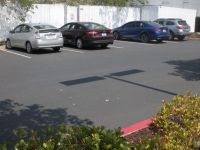
My field methods, during brief outings a few times each week, have been evolving since April.
Initially: wait for some exact hour, such as 13:00, and make a chalk mark where the pole shadow ends. If wristwatch is known to be 6 seconds behind, then make the mark when 12:59:54 is indicated. The watch-error hassle went away when I got a portable radio-controlled clock. About the same time as I found out how my analog-dial watch could be losing 5 to 10 seconds per day. On occasion, a wrist motion would unintentionally press the watch stem, thus turn on the EL backlight. Battery was so low that motor didn't step when backlight was on.
Marks made with crayon or colored pencil withstand rain better than ones made with chalk.
Exact location of the shadow (center of umbra) is still rather subjective. For more accuracy, I started marking the shadow location at a few arbitrary times shortly before and after the target time. For interpolation, mark the predicted spacing of actual and target times on a strip of paper, and fit it by eye to the chalk marks.
Instead of trying to read the clock and mark the shadow at the same time, one can make the mark 10 or 20 seconds ahead of the shadow, then note the time when shadow is centered on mark.
Finally, as of Monday this week, I started taking a photograph that shows clock time, shadow, and reference marks all at the same time. Duh! Here getting a data point for the exact ground location of lamp-post-top meridian.
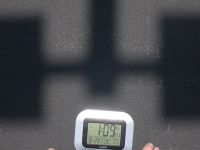
Image-processing tools like posterizing, and/or magic wand selector, can take much of the guesswork out of pinpointing the shadow tip. When the shadow is substantially oblique to the square post, I've been marking the shadow of post's corner instead of the middle of its north edge.

klugesmith, Thu Aug 25 2016, 06:47AM
Thanks for the cautionary words, Sulaiman. The lot was re-sealed early this year, for the first time since 2008, so the surface ought to be around for a while.
Here's the venue:

My field methods, during brief outings a few times each week, have been evolving since April.
Initially: wait for some exact hour, such as 13:00, and make a chalk mark where the pole shadow ends. If wristwatch is known to be 6 seconds behind, then make the mark when 12:59:54 is indicated. The watch-error hassle went away when I got a portable radio-controlled clock. About the same time as I found out how my analog-dial watch could be losing 5 to 10 seconds per day. On occasion, a wrist motion would unintentionally press the watch stem, thus turn on the EL backlight. Battery was so low that motor didn't step when backlight was on.

Marks made with crayon or colored pencil withstand rain better than ones made with chalk.
Exact location of the shadow (center of umbra) is still rather subjective. For more accuracy, I started marking the shadow location at a few arbitrary times shortly before and after the target time. For interpolation, mark the predicted spacing of actual and target times on a strip of paper, and fit it by eye to the chalk marks.
Instead of trying to read the clock and mark the shadow at the same time, one can make the mark 10 or 20 seconds ahead of the shadow, then note the time when shadow is centered on mark.
Finally, as of Monday this week, I started taking a photograph that shows clock time, shadow, and reference marks all at the same time. Duh! Here getting a data point for the exact ground location of lamp-post-top meridian.

Image-processing tools like posterizing, and/or magic wand selector, can take much of the guesswork out of pinpointing the shadow tip. When the shadow is substantially oblique to the square post, I've been marking the shadow of post's corner instead of the middle of its north edge.

Re: Anallematic horizontal sundial in parking lot
WaveRider, Thu Aug 25 2016, 01:17PM
Interesting fun field project! If you want watch setting accuracy, you might be inspired by this "sundial" found here in Belgium!
WaveRider, Thu Aug 25 2016, 01:17PM
Interesting fun field project! If you want watch setting accuracy, you might be inspired by this "sundial" found here in Belgium!

Re: Anallematic horizontal sundial in parking lot
Sulaiman, Thu Aug 25 2016, 03:31PM
I see minor divisions of 5 minutes,
even with interpolation hardly watch-setting accuracy.
The car park / lamp post will have much greater precision due to the length of the shadow path.
Sulaiman, Thu Aug 25 2016, 03:31PM
I see minor divisions of 5 minutes,
even with interpolation hardly watch-setting accuracy.
The car park / lamp post will have much greater precision due to the length of the shadow path.
Re: Anallematic horizontal sundial in parking lot
klugesmith, Thu Aug 25 2016, 11:44PM
Phase 1 is to mark a single analemma, for noon on the clock ( 1 pm when Daylight Savings Time is in effect).
Please review this preliminary (and incomplete) rendering of a plan to segment and color the curve. I finally got a thumbnail image to appear inline, by uploading a snip which is much less elongated than the whole picture.
]anotherv.jpg[/file]
]visio-analem_breaks.pdf[/file]
The horizontal line represents the local meridian just north of the lamp post. It's marked in units of post height. Vertical dashed line is where equatorial plane of post top intersects the ground. Each month is drawn in 3 segments, connecting days 1-10, 11-20, and 21-final.
Two June segments are drawn "curved" using three sub-segments. Entry would be much less tedious if I knew how to draw stuff in Visio from a command file instead of manually entering numbers in GUI size-and-position window.
klugesmith, Thu Aug 25 2016, 11:44PM
Phase 1 is to mark a single analemma, for noon on the clock ( 1 pm when Daylight Savings Time is in effect).
Please review this preliminary (and incomplete) rendering of a plan to segment and color the curve. I finally got a thumbnail image to appear inline, by uploading a snip which is much less elongated than the whole picture.
]anotherv.jpg[/file]
]visio-analem_breaks.pdf[/file]
The horizontal line represents the local meridian just north of the lamp post. It's marked in units of post height. Vertical dashed line is where equatorial plane of post top intersects the ground. Each month is drawn in 3 segments, connecting days 1-10, 11-20, and 21-final.
Two June segments are drawn "curved" using three sub-segments. Entry would be much less tedious if I knew how to draw stuff in Visio from a command file instead of manually entering numbers in GUI size-and-position window.
Re: Anallematic horizontal sundial in parking lot
klugesmith, Tue Nov 29 2016, 03:55AM
Glad to report my first paint on pavement. Last Friday was dry but cloudy, and was a company holiday. I marked the meridian line with white spray paint. A movable stencil was two strips of sheet metal placed 1/4 inch apart. The line is surprisingly obvious even from far away.
Actually it's the "working meridian" line established with colored pencil and crayon marks, months ago. Part of a grid used to measure the locations of actual shadow marks. Grid errors can go into my spreadsheet model to reconcile measured shadow coordinates with theoretical ones.
Two much bigger corrections need to go into the spreadsheet: the non-level ground and the finite apparent solar diameter. It was evident in spring and summer that the most repeatable, least subjective "end" of lamp-post shadow is where the umbra meets penumbra.
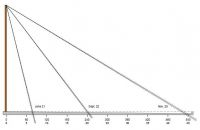
Trouble is, now that shadows are long and sundial play time is short, I think the umbra tapers to nothing. From the more distant vantage point, angular width of the square post top might be less than angular width of the sun (which is approaching the big end of its 3.3% seasonal variation).
klugesmith, Tue Nov 29 2016, 03:55AM
Glad to report my first paint on pavement. Last Friday was dry but cloudy, and was a company holiday. I marked the meridian line with white spray paint. A movable stencil was two strips of sheet metal placed 1/4 inch apart. The line is surprisingly obvious even from far away.
Actually it's the "working meridian" line established with colored pencil and crayon marks, months ago. Part of a grid used to measure the locations of actual shadow marks. Grid errors can go into my spreadsheet model to reconcile measured shadow coordinates with theoretical ones.
Two much bigger corrections need to go into the spreadsheet: the non-level ground and the finite apparent solar diameter. It was evident in spring and summer that the most repeatable, least subjective "end" of lamp-post shadow is where the umbra meets penumbra.

Trouble is, now that shadows are long and sundial play time is short, I think the umbra tapers to nothing. From the more distant vantage point, angular width of the square post top might be less than angular width of the sun (which is approaching the big end of its 3.3% seasonal variation).
Re: Anallematic horizontal sundial in parking lot
klugesmith, Wed Nov 30 2016, 03:43AM
Today I tested a new and very precise way to track a fuzzy shadow, while shadow moves eastward at a slow snail's pace (2.5 inches per minute).
Here's a simulated azimuth-altitude view, looking toward the sun at the moment it crossed the celestial meridian today, from the shadow-end at ground level.
Model includes the top 10 inches of the 5-inch square lamp post, and includes today's angular width of the sun.
The precise viewpoint is on the ground meridian, at the distance where upper limb of sun is tangent to the shadow-casting edge.
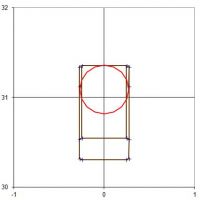
Materials:
1. thin, flat glass mirror about 3/4" square.
2. Shade 10 welder's glass, appropriate for looking at the solar disk.
Put mirror on the ground, with one edge propped up so it tilts toward the sun.
Look down at the mirror, through the welder's glass.
Move head until reflection of solar disk is centered in the mirror.
Wait for post-top and solar disk to align as shown, note the time and mark the mirror location.
Repeat, moving mirror eastward each time. Adjust the north-south position if sun passed too high or too low last time.
klugesmith, Wed Nov 30 2016, 03:43AM
Today I tested a new and very precise way to track a fuzzy shadow, while shadow moves eastward at a slow snail's pace (2.5 inches per minute).
Here's a simulated azimuth-altitude view, looking toward the sun at the moment it crossed the celestial meridian today, from the shadow-end at ground level.
Model includes the top 10 inches of the 5-inch square lamp post, and includes today's angular width of the sun.
The precise viewpoint is on the ground meridian, at the distance where upper limb of sun is tangent to the shadow-casting edge.

Materials:
1. thin, flat glass mirror about 3/4" square.
2. Shade 10 welder's glass, appropriate for looking at the solar disk.
Put mirror on the ground, with one edge propped up so it tilts toward the sun.
Look down at the mirror, through the welder's glass.
Move head until reflection of solar disk is centered in the mirror.
Wait for post-top and solar disk to align as shown, note the time and mark the mirror location.
Repeat, moving mirror eastward each time. Adjust the north-south position if sun passed too high or too low last time.
Re: Anallematic horizontal sundial in parking lot
Sulaiman, Wed Nov 30 2016, 08:59AM
would it be better to mount either a sphere or a rod gnomon parallel to Earth's axis on top of the lamp post ?
Sulaiman, Wed Nov 30 2016, 08:59AM
would it be better to mount either a sphere or a rod gnomon parallel to Earth's axis on top of the lamp post ?
Re: Anallematic horizontal sundial in parking lot
klugesmith, Fri Mar 17 2017, 09:02PM
Yes, it'd be simpler if we looked at the shadow of a ball. But I'm not equipped to climb the pole!
The project is still alive, after a winter hiatus while the shadow extended into planted area north of the pavement.
Before that, the scope had been narrowed to a single analemma for clock noon, Standard time.
It came back, fancier and more precise than ever before, beginning with observations on January 13.
The methodology using small mirror at ground level, and welders' glass, has evolved substantially.
Brief little eclipses (annular or total) were tracked from positions measured to the millimeter,
in a vague shadow zone with no umbra. Even through thin clouds, if disk of sun was visible.
It was immediately clear that the model needed to include a correction for cross-slope (east to west).
No time today for a full write-up, so I'll post a composite picture showing a Google aircraft image, a new reference grid with semi-permanent corner marks on the pavement, and the proposed analemmas. The venue is close to ideal.
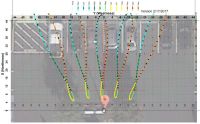
klugesmith, Fri Mar 17 2017, 09:02PM
Yes, it'd be simpler if we looked at the shadow of a ball. But I'm not equipped to climb the pole!
The project is still alive, after a winter hiatus while the shadow extended into planted area north of the pavement.
Before that, the scope had been narrowed to a single analemma for clock noon, Standard time.
It came back, fancier and more precise than ever before, beginning with observations on January 13.
The methodology using small mirror at ground level, and welders' glass, has evolved substantially.
Brief little eclipses (annular or total) were tracked from positions measured to the millimeter,
in a vague shadow zone with no umbra. Even through thin clouds, if disk of sun was visible.
It was immediately clear that the model needed to include a correction for cross-slope (east to west).
No time today for a full write-up, so I'll post a composite picture showing a Google aircraft image, a new reference grid with semi-permanent corner marks on the pavement, and the proposed analemmas. The venue is close to ideal.

Re: Anallematic horizontal sundial in parking lot
klugesmith, Mon Mar 20 2017, 07:55AM
This stuff will have to be dribbled in, bit by bit. And some day consolidated.
The other day I finally made a plane-of-the-sky chart of sun position errors. My shadow modeling is all done in MS Excel spreadsheets. The foundation is a .xls file downloadable from NOAA, with self-contained formulas for solar ephemeris calculations. It's accurate within a few seconds of time over many years. It includes columns for computing apparent solar zenith angle and azimuth angle at any designated place on Earth surface.
NOAA_Solar_Calculations_year.xls from
[edit] The equations and coefficients are credited to Astronomical Algorithms, by Jean Meeus. [\edit]
For projects needing more accuracy, in pre-Internet days we would open a paper book full of tables, called the Astronomical Almanac, for the current year. Nowadays it's much easier. From the U.S. Naval Observatory data services page, we can generate tables with user-selected time periods and resolution. For the sundial application, go to and select Geocentric Positions of Major Solar System Objects and Bright Stars:
and select Geocentric Positions of Major Solar System Objects and Bright Stars:  Example output:
Example output:

For a more intuitive view of the Declination and Equation of Time errors, we can chart them with respect to each other over the whole four-year data set. Red circle shows the average extent of the solar disk. At the same scale, black markers show the position error from using the NOAA formula. Other thin lines show the error, magnified by ten, year by year.

Before finding the self-contained formulas, set up in spreadsheet cells by somebody else, I used tabular data from USNO and trivial interpolation formulas. A bit more accurate for matching field observations . But for drawing sundials good for more than one year, those real irregularities interfere.
. But for drawing sundials good for more than one year, those real irregularities interfere.
Those tables downloaded from USNO site are not the best in the world. I think a good way to get fancier would be to start with the Solar System Dynamics group at JPL. Their work has been fundamental to deep-space-probe navigation for many decades.
Their work has been fundamental to deep-space-probe navigation for many decades.
klugesmith, Mon Mar 20 2017, 07:55AM
This stuff will have to be dribbled in, bit by bit. And some day consolidated.
The other day I finally made a plane-of-the-sky chart of sun position errors. My shadow modeling is all done in MS Excel spreadsheets. The foundation is a .xls file downloadable from NOAA, with self-contained formulas for solar ephemeris calculations. It's accurate within a few seconds of time over many years. It includes columns for computing apparent solar zenith angle and azimuth angle at any designated place on Earth surface.
NOAA_Solar_Calculations_year.xls from

[edit] The equations and coefficients are credited to Astronomical Algorithms, by Jean Meeus. [\edit]
For projects needing more accuracy, in pre-Internet days we would open a paper book full of tables, called the Astronomical Almanac, for the current year. Nowadays it's much easier. From the U.S. Naval Observatory data services page, we can generate tables with user-selected time periods and resolution. For the sundial application, go to
 and select Geocentric Positions of Major Solar System Objects and Bright Stars:
and select Geocentric Positions of Major Solar System Objects and Bright Stars:  Example output:
Example output: Sun
Apparent Geocentric Positions
True Equator and Equinox of Date
Date Time Right Declination Distance Equation
(UT1) Ascension of Time
h m s h m s ° ' " AU m s
2017 Mar 17 00:00:00.0 23 47 27.361 - 1 21 30.02 0.994963120 - 8 25.1
2017 Mar 18 00:00:00.0 23 51 06.547 - 0 57 47.01 0.995244208 - 8 07.7
2017 Mar 19 00:00:00.0 23 54 45.578 - 0 34 03.85 0.995527233 - 7 50.2
2017 Mar 20 00:00:00.0 23 58 24.473 - 0 10 20.87 0.995811896 - 7 32.5
2017 Mar 21 00:00:00.0 0 02 03.255 + 0 13 21.54 0.996097887 - 7 14.8Dates must all be in the current calendar year, last year, or next year. 2015 is no longer accessible, but I saved a sun table for every day of that year at 20h UT (clock noon in my time zone). Year 2018 has been accessible for 2 1/2 months now, and I just appended its sun table to my comparison spreadsheet. Here is a chart of the discrepancy between the online USNO ephemeris and the self-contained formulas in spreadsheet from NOAA:
For a more intuitive view of the Declination and Equation of Time errors, we can chart them with respect to each other over the whole four-year data set. Red circle shows the average extent of the solar disk. At the same scale, black markers show the position error from using the NOAA formula. Other thin lines show the error, magnified by ten, year by year.

Before finding the self-contained formulas, set up in spreadsheet cells by somebody else, I used tabular data from USNO and trivial interpolation formulas. A bit more accurate for matching field observations
 . But for drawing sundials good for more than one year, those real irregularities interfere.
. But for drawing sundials good for more than one year, those real irregularities interfere. Those tables downloaded from USNO site are not the best in the world. I think a good way to get fancier would be to start with the Solar System Dynamics group at JPL.
 Their work has been fundamental to deep-space-probe navigation for many decades.
Their work has been fundamental to deep-space-probe navigation for many decades.Re: Anallematic horizontal sundial in parking lot
Sulaiman, Mon Mar 20 2017, 04:48PM
I like the last figure, the error plots.
You may need a callibration device
Sulaiman, Mon Mar 20 2017, 04:48PM
I like the last figure, the error plots.
You may need a callibration device

Re: Anallematic horizontal sundial in parking lot
klugesmith, Mon Feb 26 2018, 08:36AM
Hey, I'm finally striping some pavement, starting a couple weeks ago. The project has evolved from observation & modeling, to progressively more efficient ways to make stencils.

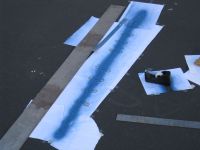
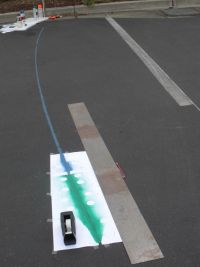
The two sides of each stencil are connected with bridges, one per day, with a wide one for day numbers that end in 1 or 6, and a whole-day gap between months.
Soon it will be time to add words like JANUARY and FEBRUARY. At the hardware store they sell sets of individual letters, die-cut in heavy paper. It would take at least two sets; a lot more if I want to assemble all 12 months at the same time. Anyone know an easier way? Want a laser-cutting project?
Also just took the opportunity to correct my misspelling of analemma in a couple of posts more than a year old. Please excuse a mnemonic which may be hard to unread or unremember: Anal Emma.
klugesmith, Mon Feb 26 2018, 08:36AM
Hey, I'm finally striping some pavement, starting a couple weeks ago. The project has evolved from observation & modeling, to progressively more efficient ways to make stencils.



The two sides of each stencil are connected with bridges, one per day, with a wide one for day numbers that end in 1 or 6, and a whole-day gap between months.
Soon it will be time to add words like JANUARY and FEBRUARY. At the hardware store they sell sets of individual letters, die-cut in heavy paper. It would take at least two sets; a lot more if I want to assemble all 12 months at the same time. Anyone know an easier way? Want a laser-cutting project?
Also just took the opportunity to correct my misspelling of analemma in a couple of posts more than a year old. Please excuse a mnemonic which may be hard to unread or unremember: Anal Emma.
Re: Anallematic horizontal sundial in parking lot
klugesmith, Thu Mar 08 2018, 07:09AM
The eastern arc runs close to the parking lot drain, and Tuesday morning I checked the ground slope with due diligence. Had marked approximate Y location of that curve, every 2 feet in X, based on known profile along the meridian. Then moved a laser level to each of those spots, and projected it to a fixed target set where meridian meets curb.

Marked each spot's height on paper, graphically recording a profile which could be measured later, and re-measured in case of a blunder with the numbers.
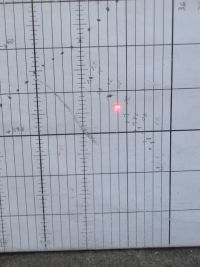
In the same session, re-measured part the meridian profile using different symbols, to fix the new east-arc profile with respect to a familiar reference.
Updating the Z profile in my spreadsheet moved the predicted day-mark locations slightly. Some as much as 1 or 2 cm, mostly in X (roughly parallel to the curve).
Then I cut my first stencil made from paper in a continuous roll. Did the section from x=34' to X-40', representing noon shadows between November 3 and November 19. The longest so far, and the first with paint in the color chosen for autumn months.
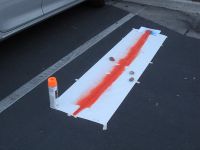
klugesmith, Thu Mar 08 2018, 07:09AM
The eastern arc runs close to the parking lot drain, and Tuesday morning I checked the ground slope with due diligence. Had marked approximate Y location of that curve, every 2 feet in X, based on known profile along the meridian. Then moved a laser level to each of those spots, and projected it to a fixed target set where meridian meets curb.

Marked each spot's height on paper, graphically recording a profile which could be measured later, and re-measured in case of a blunder with the numbers.

In the same session, re-measured part the meridian profile using different symbols, to fix the new east-arc profile with respect to a familiar reference.
Updating the Z profile in my spreadsheet moved the predicted day-mark locations slightly. Some as much as 1 or 2 cm, mostly in X (roughly parallel to the curve).
Then I cut my first stencil made from paper in a continuous roll. Did the section from x=34' to X-40', representing noon shadows between November 3 and November 19. The longest so far, and the first with paint in the color chosen for autumn months.

Re: Anallematic horizontal sundial in parking lot
Sulaiman, Thu Mar 08 2018, 12:21PM
I'm glad to see that you are progressing,
I'd not considered the flatness of the car park,
mainly because the car park at my factory is concrete,
but thinking about it, even the concrete has a slight gradient for drainage.
annoying details.
just to put you on the spot;
How accurate do you now guesstimate your sundial will be ?
Sulaiman, Thu Mar 08 2018, 12:21PM
I'm glad to see that you are progressing,
I'd not considered the flatness of the car park,
mainly because the car park at my factory is concrete,
but thinking about it, even the concrete has a slight gradient for drainage.
annoying details.
just to put you on the spot;
How accurate do you now guesstimate your sundial will be ?
Re: Anallematic horizontal sundial in parking lot
klugesmith, Tue Mar 20 2018, 05:25AM
Got a chance to check accuracy today, with only thin clouds in the sky after a solid week of rain. The Sun's ascent toward the equator has almost caught up with the extent of my green stripe. The view is from the north. Shadow, moving right to left, is supposed to cross the line an hour after noon (Pacific Daylight Time).
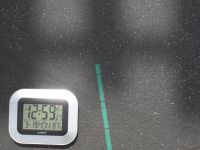

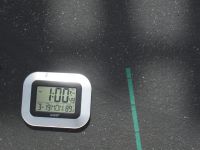
Also took the opportunity to extend the orange line by six feet, tying my previous record for longest stencil.

This part covers October 20 to November 2. Not sure why my pencil marks from 2 weeks ago are 4 mm east of today's measurements (and stencil placement).
klugesmith, Tue Mar 20 2018, 05:25AM
Got a chance to check accuracy today, with only thin clouds in the sky after a solid week of rain. The Sun's ascent toward the equator has almost caught up with the extent of my green stripe. The view is from the north. Shadow, moving right to left, is supposed to cross the line an hour after noon (Pacific Daylight Time).



Also took the opportunity to extend the orange line by six feet, tying my previous record for longest stencil.

This part covers October 20 to November 2. Not sure why my pencil marks from 2 weeks ago are 4 mm east of today's measurements (and stencil placement).
Re: Anallematic horizontal sundial in parking lot
Uspring, Tue Mar 20 2018, 11:47AM
That's impressively accurate considering the suns size worth more than 10 min. Perhaps a gust of wind bent the lamp pole.
Possible is also uneven thermal expansion of the pole. An 8m iron pole of 10cm diameter will bend 3mm per degree temperature difference across it.
Uspring, Tue Mar 20 2018, 11:47AM
That's impressively accurate considering the suns size worth more than 10 min. Perhaps a gust of wind bent the lamp pole.
Possible is also uneven thermal expansion of the pole. An 8m iron pole of 10cm diameter will bend 3mm per degree temperature difference across it.
Re: Anallematic horizontal sundial in parking lot
klugesmith, Wed May 09 2018, 06:03AM
Uspring: that unexplained discrepancy was between new and old pencil marks drawn _from_ spreadsheeted coordinates. Probably due to operator error.
Making stencils by hand was getting tedious, and the sun got a month ahead of my spray paint while I looked into laser-cut stencils. Need to get drawing in an appropriate file format, with vector coordinates automatically imported from spreadsheet.
Then, last week, electricians started replacing all the sodium vapor luminaires with LED units. I hope they have not accidentally moved my pole.

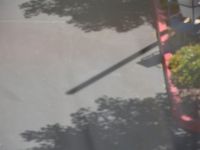
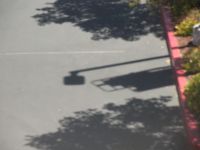
The new lights are smaller, but their arms bolted to the pole are thicker and extend higher than before. I think it will still be easy to identify the pole top in noon shadows, but maybe not so well in the oblique shadows that would touch sundial lines for 10h or 14h.
The work on "my" pole was finished an hour before shadow-on-meridian time, and I took a now-very-routine observation. Haven't yet compared it with the prediction. Three photographs, at least 30 s apart, with clock and shadow on a paper grid. A few minutes late in this case.
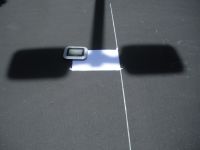
Then each image is viewed on computer screen, zoomed to actual size. Locating "top center" is facilitated by image editing tools like "magic wand" selection or posterizing, which are essential with faint and fuzzy winter shadows.

klugesmith, Wed May 09 2018, 06:03AM
Uspring: that unexplained discrepancy was between new and old pencil marks drawn _from_ spreadsheeted coordinates. Probably due to operator error.
Making stencils by hand was getting tedious, and the sun got a month ahead of my spray paint while I looked into laser-cut stencils. Need to get drawing in an appropriate file format, with vector coordinates automatically imported from spreadsheet.
Then, last week, electricians started replacing all the sodium vapor luminaires with LED units. I hope they have not accidentally moved my pole.



The new lights are smaller, but their arms bolted to the pole are thicker and extend higher than before. I think it will still be easy to identify the pole top in noon shadows, but maybe not so well in the oblique shadows that would touch sundial lines for 10h or 14h.
The work on "my" pole was finished an hour before shadow-on-meridian time, and I took a now-very-routine observation. Haven't yet compared it with the prediction. Three photographs, at least 30 s apart, with clock and shadow on a paper grid. A few minutes late in this case.

Then each image is viewed on computer screen, zoomed to actual size. Locating "top center" is facilitated by image editing tools like "magic wand" selection or posterizing, which are essential with faint and fuzzy winter shadows.

Re: Anallematic horizontal sundial in parking lot
klugesmith, Sat Mar 30 2019, 10:45PM
This year I'm staying ahead of the sun. Let's see if inline image is too big.


Got custom-cut stencils for the names of the months, and numbers 6, 11, 16, 21, and 26. February and March sections are already numbered at the 11th and 21st.
February and March sections are already numbered at the 11th and 21st. 
Hand-cutting the line stencils is measurably tedious. Yesterday I made one to extend line for 17 days, and it took about 1 hour: selecting day-marker shapes in Visio, typing XY coordinates and angles from Excel, printing, joining two 11 x 17 inch sheets, and cutting with x-acto knife and straight edge. Then it was too dark to place it and use it outdoors.
Looking for suggestions about practical ways to make vector graphic files, so I can finish the project using custom laser-cut stencils. It looks like generating .svg or .dxf files from scratch is manageable. General requirement: insert dozens of polygons (trapezoids) with computer-generated vertex locations. Not using much pointing, dragging, or clicking with mouse. That's why inkscape seems unpromising.
Is there any free drawing program that lets you 1) draw a polygon using nothing but keystrokes, and 2) execute drawing commands from a text file? Decades ago I would do that in Autocad.
klugesmith, Sat Mar 30 2019, 10:45PM
This year I'm staying ahead of the sun. Let's see if inline image is too big.


Got custom-cut stencils for the names of the months, and numbers 6, 11, 16, 21, and 26.
 February and March sections are already numbered at the 11th and 21st.
February and March sections are already numbered at the 11th and 21st. 
Hand-cutting the line stencils is measurably tedious. Yesterday I made one to extend line for 17 days, and it took about 1 hour: selecting day-marker shapes in Visio, typing XY coordinates and angles from Excel, printing, joining two 11 x 17 inch sheets, and cutting with x-acto knife and straight edge. Then it was too dark to place it and use it outdoors.
Looking for suggestions about practical ways to make vector graphic files, so I can finish the project using custom laser-cut stencils. It looks like generating .svg or .dxf files from scratch is manageable. General requirement: insert dozens of polygons (trapezoids) with computer-generated vertex locations. Not using much pointing, dragging, or clicking with mouse. That's why inkscape seems unpromising.
Is there any free drawing program that lets you 1) draw a polygon using nothing but keystrokes, and 2) execute drawing commands from a text file? Decades ago I would do that in Autocad.
Re: Anallematic horizontal sundial in parking lot
klugesmith, Sun Mar 31 2019, 08:35PM
Yay! Just downloaded Draftsight Free (which is going to stop at the end of December 2019).
Very much like Autocad, and you can draw anything with command line entries.
Within an hour I had exported .svg and .dxf files from an initially blank drawing with these figures added:
Only complaint is against Microsoft. The draftsight/autocad script file had extension .scr.
Windows has a different use for that extension. When you browse to the file and want to open it with a text editor, Windows doesn't provide the right-click,Open-With option. A whole generation has now grown up with the silly concept that a file's name extension dictates the program for that file. Guess that's OK, since Windows is for dummies.
A whole generation has now grown up with the silly concept that a file's name extension dictates the program for that file. Guess that's OK, since Windows is for dummies.
klugesmith, Sun Mar 31 2019, 08:35PM
Yay! Just downloaded Draftsight Free (which is going to stop at the end of December 2019).
Very much like Autocad, and you can draw anything with command line entries.
Within an hour I had exported .svg and .dxf files from an initially blank drawing with these figures added:
POLYLINE 2,2 2,3 2.5,3.1 2.5,1.9 CLOSE POLYLINE 1,2 1,3 1.5,3.1 1.5,1.9 CLOSE
Only complaint is against Microsoft. The draftsight/autocad script file had extension .scr.
Windows has a different use for that extension. When you browse to the file and want to open it with a text editor, Windows doesn't provide the right-click,Open-With option.
 A whole generation has now grown up with the silly concept that a file's name extension dictates the program for that file. Guess that's OK, since Windows is for dummies.
A whole generation has now grown up with the silly concept that a file's name extension dictates the program for that file. Guess that's OK, since Windows is for dummies.Re: Anallematic horizontal sundial in parking lot
klugesmith, Sun Jun 23 2019, 07:08AM
Hey Sulaiman, you still around?
Today I finished painting the analemma curve for clock noon. Yay!
Sprayed the second half of August, using one of 3 sections on laser-cut Mylar stencil; it lines up nicely with faded old line for September. Then used a newly cut paper stencil to fill a gap of a few days in May, connecting end of old line to beginning of laser-cut stenciled section. And added the month names September and October.
All that's missing is the numbering for 11th and 21st day of months after April. The stencils for 11 and 21 are temporarily lost, though I saw them somewhere earlier this month.
Pictures to follow, when I have time to remember or find or reset my login and password for one of the photo-sharing sites.
klugesmith, Sun Jun 23 2019, 07:08AM
Hey Sulaiman, you still around?
Today I finished painting the analemma curve for clock noon. Yay!
Sprayed the second half of August, using one of 3 sections on laser-cut Mylar stencil; it lines up nicely with faded old line for September. Then used a newly cut paper stencil to fill a gap of a few days in May, connecting end of old line to beginning of laser-cut stenciled section. And added the month names September and October.
All that's missing is the numbering for 11th and 21st day of months after April. The stencils for 11 and 21 are temporarily lost, though I saw them somewhere earlier this month.
Pictures to follow, when I have time to remember or find or reset my login and password for one of the photo-sharing sites.
Re: Anallematic horizontal sundial in parking lot
Sulaiman, Sun Jun 23 2019, 09:31AM
I'm still around,
I've not commented lately as I've had nothing constructive to add.
I'm in Malaysia (approx 3 degrees North of the equator) at the moment,
preparing to move back here later this year.
In UK I'd 'considered' making a sundial for many years,
but never got around to it,
so I'll be 'considering' polar, or more likely, equinoctial.
I'm glad to see that you've stuck at it and will finish it,
I often start projects to learn stuff
and find that I've learned enough before the project is finished :)
so I abandon the project :(
Sulaiman, Sun Jun 23 2019, 09:31AM
I'm still around,
I've not commented lately as I've had nothing constructive to add.
I'm in Malaysia (approx 3 degrees North of the equator) at the moment,
preparing to move back here later this year.
In UK I'd 'considered' making a sundial for many years,
but never got around to it,
so I'll be 'considering' polar, or more likely, equinoctial.
I'm glad to see that you've stuck at it and will finish it,
I often start projects to learn stuff
and find that I've learned enough before the project is finished :)
so I abandon the project :(
Print this page